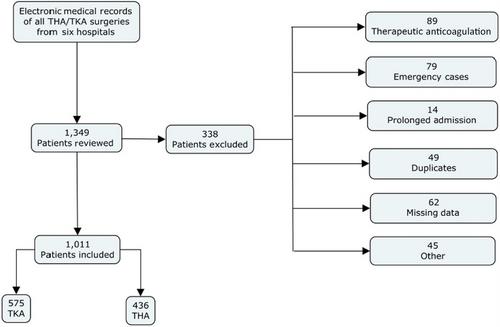Prevention of venous thromboembolism after total hip and knee arthroplasties in Australian hospitals: what are we using?
Abstract
Background
Venous thromboembolism (VTE) is a leading cause of preventable morbidity and mortality, with total hip arthroplasty (THA) and total knee arthroplasty (TKA) at the highest risk. Safe and appropriate thromboprophylaxis is essential. However, investigations into prescribing practices have been limited.
Aim
To describe current VTE prophylaxis regimens in Australian patients following an elective THA/TKA and compare these regimens to an international standard.
Method
A retrospective multisite case series of patients admitted for a THA/TKA in six tertiary hospitals in Queensland, Australia, was conducted over 12 months (1 October 2017–30 September 2018). Patient and medication data were collected following surgery and for 60 days after discharge to determine changes to the patients' thromboprophylaxis regimen. Results were summarised and compared to National Institute for Health and Care Excellence (NICE) guidelines. Ethical approval was granted by the Metro South Human Research Ethics Committee (Reference no: HREC/2018/QMD/46757) and the study conforms to the National Statement on Ethical Conduct in Human Research.
Results
The study included 1011 patients (43.1% THA, 56.9% TKA), and thromboprophylaxis was used in 98.1% of inpatients and in 94.3% of discharge patients for 5.2 (±5.2) and 29.2 (±15.9) days (±standard deviation) respectively. Low-molecular-weight heparins (LMWHs) were the primary drugs for inpatients (71.2%) and aspirin 150 mg for discharge (42.0%), most commonly for 6 weeks (31.8%). Aspirin was used for significantly longer duration than rivaroxaban and LMWH (p < 0.001). A two-staged prophylaxis regimen was implemented, most commonly any anticoagulant as an inpatient; followed by rivaroxaban on discharge (32.7%) or an anticoagulant as an inpatient with aspirin on discharge (26.4%). Overall, adherence to NICE guidelines was low; THA: 8.7%, TKA: 5.9%.
Conclusion
VTE prophylaxis regimens varied considerably, and consequently, adherence to international guidelines was low. There is a need for local, peer-led guidelines to ensure consistent, safe, and effective prophylaxis.


 求助内容:
求助内容: 应助结果提醒方式:
应助结果提醒方式:


